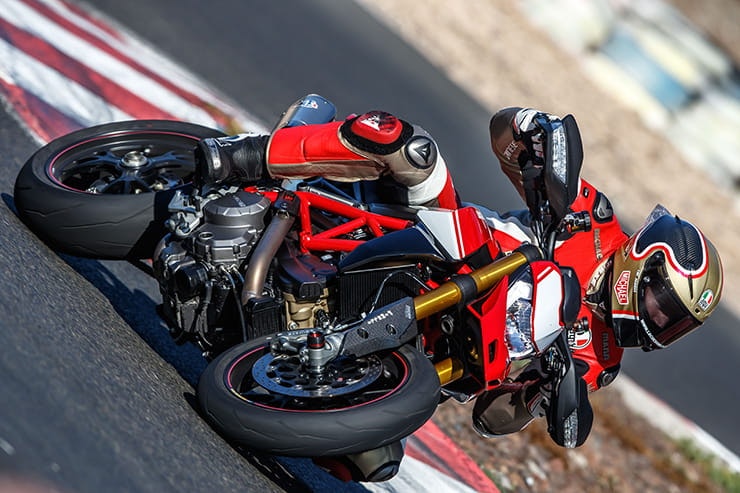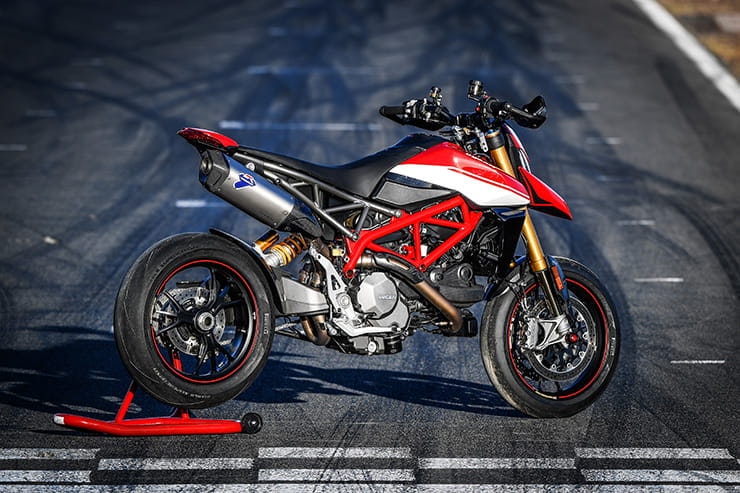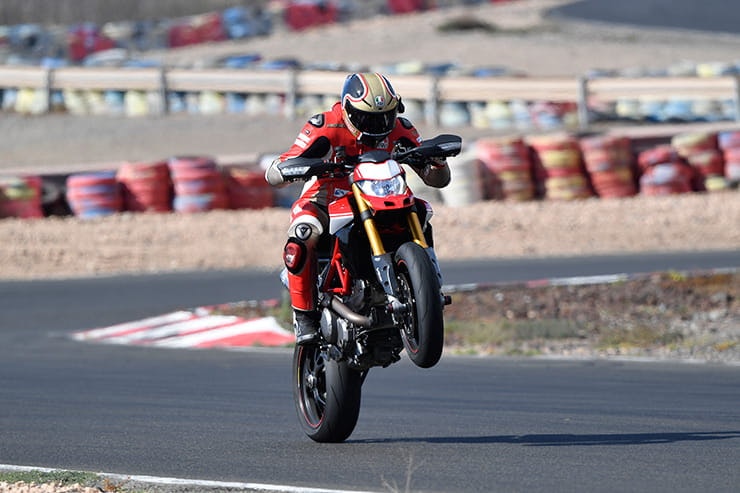Ducati Hypermotard 950 SP (2019) - Review
By Michael Mann
BikeSocial Managing Editor
28.01.2019
Not one but two new Hypermotard’s are hitting Ducati’s 2019 model range and we’ve been to the press launch in Gran Canaria to ride the standard version on the road while the more refined SP spec bike has been reserved for maximum lairyness on the Maspalomas track. How much entertainment can 113bhp offer? Is it crazy enough? Well, I’ll tell you this; I’ve begun writing this several hours after riding and I’m still buzzing.
‘What’s the difference between the two bikes?’, I hear you say. Easy, the SP comes with Ohlins suspension all around instead of Marzocchi forks and a Sachs monoshock on the standard model , and those easily identifiable gold tubes contribute to the 20mm extra seat height, up to 890mm, and a 5mm longer wheelbase. Also different on the two variations are the W-shaped 3-spoke Marchesini forged light alloy wheels and Pirelli Diablo Supercorsa SP as opposed to Y shaped 3-spoke light alloy wheels shod with Pirelli Diablo Rosso III’s on the standard bike, all of which means a 2kg kerb weight difference with the SP weighing in at 198kg. The SP also comes with an up-and-down quickshifter as standard, a handful of carbon bits and a racier paint job.
VIDEO REVIEW: Ducati Hypermotard 950 (and 950 SP)
BikeSocial's Michael Mann reports from the International Press Launch in Gran Canaria offering his first thoughts of the 2019 Ducati.
Gold forks and white paint denotes SP
2019 Ducati Hypermotard 950 Price
Here it comes; the standard Hypermotard 950 is in dealerships now priced at £10,995 while the Hypermotard 950 SP is expected by mid-February at a bulky £14,295.
PCP examples look like this:
Power and torque
Despite the 939 becoming the 950 for 2019, confusingly the Ducati Testastretta 11° twin cylinder engine remains with a 937cc capacity although has enjoyed an overhaul. Lighter by 1.5kg thanks to new pistons, exhaust system and cam profile, cam cover, clutch, ECU, throttle bodies and a higher compression rate leads to an increase in power too, by 4bhp over its predecessor, with a peak of 112.6bhp (84kW) at 9000rpm.
The peak torque figure is a hearty 71 lb-ft (96 Nm) at 7250rpm but that’s not the full story. 80% of that torque is available at just 3000rpm and 88% of it between 5000 – 9000rpm which gives plenty of bite alongside that traditional and booming Ducati L-Twin bark.
A new Ride-by-Wire throttle give almost instance response, there’s a tiny amount of slack before the meat of the motor is on tap but blink and you’d miss it. And as you drive out of a corner there’s no holding this thing back depending which power, traction and wheelie settings your preference is of course. And it’s accompanied by that wonderful noise which makes it sound to anyone within earshot like every effort is being made to deafen them.
Use it in the rain and the oil cooler looks likely to get coated, while the standard exhausts are shown next to the Termignoni twin slip-on accessories
Engine, gearbox and exhaust
The heart of this big lively supermotard that has long been the crazy cousin of the Ducati family needs to be lively, that’s what drives the focus of the machine. It’s a free-revving and torque rich motor that craves punishment. Twist the throttle back and you can almost hear it squeal with delight. More, it tells me, more. Feed it gears, snicking up at around the 9000rpm mark, and it continues to thrust on. A delight for the senses that has the potential to become an assault with the lack of weather protection, you’ll be fine below 80mph though. To give Ducati its due there’s a small carbon fibre screen available as an accessory though a) I’m not sure how much it’ll help, and b) a bike like this is about as useful on a motorway as a Panigale is on a go-kart circuit.
But does it need any extra horses, or even torque? Yes, I think so – another 10-15bhp or a lift of a few more lbs-ft across the whole rev range would offer the type of scare value this mad-hatter should an even could provide. After all, wheelie control will save the front end from waggling about. Here’s a thought; what if Ducati made a Hypermotard 1260? <Pause, let that soak in>. Pah, it’d too heavy and too outrageous…but talk about barmy. It’d be as ferocious as a pissed off brown bear with rabies.
Back to reality. Modifications with the intake and exhaust systems mean a smoother bottom end to the rev range that previously had a slightly lumpy feel for those plodding around in traffic and while the exposed nature of the motor, and in particular the oil cooler, are susceptible to weather, there won’t be many in their right mind ride the Hypermotard in the rain.
The full 2-into-1 Termignoni exhaust system which were fitted to the SP bike I rode on the track offers an extra 4.9bhp but at £1665 + VAT, it’s an extreme amount of buck for a little more boom and beef. Bbrrrrraaaaaaappp. I think the bikes suits a twin exhaust set-up especially when the 2019 model has been designed for an under seat exhaust exit. So, the twin type-approved Termignoni silencers will set you back a mere £1170 + VAT instead. Either way the standard exhaust as viewed from the rear isn’t the prettiest.
An up-and-down quickshifter comes fitted to the SP model but is an official accessory for the standard model (£512.80 +VAT) which is a shame because in my opinion we now ride in an era where sports-focused machinery should offer clutchless upshifts at the very least. The light clutch action of both bikes makes the getaway problem-free while the gearbox on the SP is lusciously on point.
On the roads and the standard bike is highly accomplished
2019 Ducati Hypermotard 950 Economy
This is not a bike to slam some serious motorway miles on due to comfort and weather protection but primarily because, thankfully, it sole focus is to entertain. The 14.5 litre tank is deliberately narrow and further forward to aid weight transfer and agility but also, primarily, to ensure the seat and chassis remain accessible to riders of all heights. The claimed 55.4 mpg would be more realistic than the actual economy of 43.5mpg on our test road route which incorporated all the elements that count against fuel saving – switch backs, elevation...and journalists.
Power and torque curve (with European figures)
Handling, suspension, chassis and weight
The pièce de résistance is the way in which the Hypermotard gobbles up corners. With ‘rider ergonomic amendments’ high on the list of important stuff for this project, the Ducati engineers have provided an updated very Ducati-esque trellis frame and subframe that save 1kg over the outgoing model. Even with the 916-inspired exhaust system that reverts back to an under-seat style, the exhaust heat through the seat is not as noticeable as I perhaps feared. Lithe, athletic and very track compliant, the riding position is sporty and aggressive despite being so upright. You feel tilted over the front wheel which aids grip and to get the bike into the corners whereas a slimmer fuel tank/frame area will be music to the ears of those with a shorter inside leg, so don’t discount it if an 870mm seat height (+20mm on the SP) usually seems daunting.
The Hypermotard is not one for the motorway and rarely would the seat be restful enough after 50 miles but that’s all fine because it doesn’t pretend to be something that it’s not. We see many motorcycles trying to do too much but this Ducati is focused. It knows what it is good at and sticks to it.
Point it at a corner, in the traditional manner or with the rear end sliding (so I witnessed the great Ruben Xaus doing in a marketing video as he tested the ‘slide-by-brake’ electronic system to its limit – one-handed of course), and the nose aims to the apex with little rider interference. It’s light enough to need minimal persuasion too. Pick it up on the throttle and with the right wheelie control setting, the front just lifts and hovers – if you’ve never wheelied a bike before then try this. It makes anyone look good.
Super smart and fully adjustable, upside-down Ø 48 mm Ohlins forks offer 185mm wheel travel at the front along with its accompanying monoshock at the rear played beautifully into the hands of the track. The travel is increased versus the previous model by 15mm/25mm receptively. The smooth tarmac meant little in the way of a proper road test but under heavy braking and hard acceleration they offered smooth stability and transition. Even when the front comes down post-wheelie, the compression soaks it all up then almost tuts as it goads the rider into trying harder. A senior Ducati engineer told me they’d not adjusted any of the suspension settings for the track from the standard settings and frankly if you don’t notice anything untoward then it’s a fair chance it’s all working as it should. And the way in which the Ducati is suspended is yet again fair testament to premium products being selected for a premium brand. The price starts to justify itself all of a sudden.
The more road-biased Pirelli rubber on the standard model is coupled with the Marzocchi forks and Sachs monoshock which still manages with the weight transfer and progressively more slippery surfaces the further up the mountain we rode with plenty of composure.
The SP tips the wet weight scales at 198kg, just 2kg less than the standard model which in turn is 4kg lighter than the Hypermotard 939.
2019 Ducati Hypermotard 950 Brakes
In a word: stunning. You expect nothing less from a Brembo set-up bringing 200kg of Ducati plus its plump rider down to a corner-relevant speed. And while a set of even higher-spec M50 calipers would provide even plusher stopping power, I had no arguments with the set-up. On track the braking was smooth, progressive and stable, working in harmony with the slick set of Ohlins.
Flat in fourth at 105mph, piling towards the first corner on the Circuito Maspalomas, a second-gear hairpin with an unsighted uphill braking point, yet I trusted the anchors to get hauled up in time to make the turn-in point. Flick it in and set about punishing the sticky Pirelli’s on the exit. Oh yes. Transfer that ability to the road and on too many occasions I’d braked too early.
SP on track
Arm-achingly awesome, this hard-charging, hard-accelerating and hardcore Ducati is the real deal for mucking about on a tight and twisty track, just as the SP moniker would suggest. Its premium nature is evident throughout which confirms its track ability. Using all the revs in the second, third and fourth is all I need on this circuit. Or down to first gear if you fancied a bit Ruben Xaus-style backing-in which this bike will offer the confidence to do so – its designed that way. Smashing through the revs using all of the 10,000 or so on offer, the limiter can be quickly found but the quickshifter helps keep the power coming. It’s almost unique the way in which you sit on top of the bike yet feel so sport at the same time. Push the wide motard-style bars towards the apex hard into the corners and the pegs will scrape but only to save more vital components from doing so.
Before riding I knew the new bike’s agility was not to be questioned yet it still surprised, with a chassis that craves corners and big lean angles; 47 being the maximum incidentally. Pushing the riders weight over the front wheel makes for fast-turning mixed with front end grip and I’ve never flicked from side-to-side with such ease and confidence as in the left-right second-gear chicane. Flick and lean, get up and over to the side and repeat. The bike remains unflustered a giving you the chance to work the traction control and grip.
Rider aids and extra equipment / accessories
A fancy-sounding and super-trick 6-axis Bosch IMU (Inertia Measurement Unit) controls three rider modes. Each is customisable with ease thanks the new Panigale V4-inspired TFT display – it even has a little diagram showing, for example, what the different wheelie control settings refer to. Operationally, the buttons are the same as many other modern Ducati models and once you’re used to them, make perfect sense.
SPORT, TOURING and URBAN are your three choices and are interchangeable on the fly by closing the throttle momentarily when the next mode is selected. They come with default settings for Power, ABS, Traction (DTC) and Wheelie Control (DWC) – each of these are then customisable if required. Eight settings plus off for both DTC and DWC whereas ABS has three levels. The power in the three main maps are separated by the throttle control setting (Sport, Road and Safe) and while all 113bhp is on tap in Sport and Touring, this is cut down to 74bhp in Urban mode.
Wheelie control is the best invention for a bike like the Hypermotard. Controllable lift and hovering makes the rider look super-talented by simply winding the throttle on as aggressively as you want. ABS settings include the swish Cornering ABS system and also detects rear-wheel lift for the hard-brakers or stoppie masters. All important stuff when you’re hammering through the commute.
As mentioned, the quickshifter works both up and down and while it comes fitted on the SP, it’s an option on the standard model.
Rivals
Looking at the current crop of nimble, fun-tastic, adrenaline-emanating, smile-enhancers on the market and this is where I see the Hypermotard 950 sitting, although none can touch the Ducati for electronics and top level components.
You could probably argue that a KTM 790 Duke or Triumph Street Triple RS could be involved too. In terms of price, the SP seems a mile off and perhaps more akin to a Yamaha MT-10SP, BMW S1000R or MV Agusta Brutale 800.
2019 Ducati Hypermotard 950 verdict
Ok, so I understand the two models have to be different enough to warrant having both an SP and a standard version with budgets of all customers in mind but the price of the SP bike is steep while the standard model craves a quickshifter. It’s a fair assumption that if the two were closer in price then the SP would outsell the other just because customers want the plusher machine but a £3300 difference for suspension, tyres, a couple of kg and a quickshifter is becoming harder to justify.
As a second bike it makes perfect sense as a weekend warrior, city crusher or even occasional track basher but +£14k is a hefty sum for second bike. Premium? Yes. Justifiably impractical, single-minded and bonkers good? Absolutely.
Price aside, not only does the suite of electronics impress but the ease of which they are adjustable to suit any rider’s needs, all viewed in a smart TFT display, is top class. While the handling, especially the SP on track, is worthy of high praise – the stability and agility is like nothing else in its category. Perfectly poised with its array of top spec kit all working in harmony while the bellowing, booming L-Twin below piles in with its torque and power. An impressive short circuit weapon and a hoot in the hills. In traffic, the Ducati is slim enough to weave through the smallest of gaps like Marc Marquez when he starts from the back of the grid yet tall enough to see over car roofs.
Sometimes it’s not about looks, it’s about the way a bike makes you feel. And if you could box up the adrenaline this creates then L’eau d’hypermotard950 pour homme or femme would be a Christmas best-seller.
Three things I loved about the 2019 Ducati Hypermotard 950 …
A whole lot of hooligan
Electronics package and adjustability
Athletic and stable
Three things that I didn’t…
SP is pricey, Standard model should have a quickshifter as standard
No fuel gauge on either
SP too tall for some
2019 Ducati Hypermotard 950 spec
To insure this bike, click here
To learn more about what the spec sheet means, click here for our glossary


